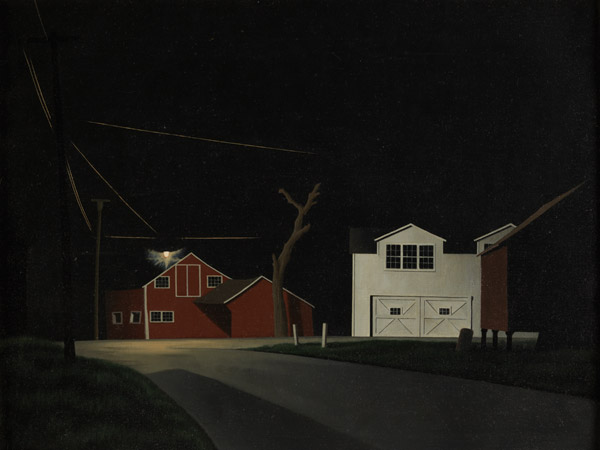I recently realized just how much influence a museum can have on one’s perception of an artist and his or her work. In November of 2011, I went to the Kemper Museum of Contemporary Art and spent an afternoon browsing through the galleries. In one of the smaller galleries, I saw an exhibit dedicated to George Ault.
I’d never heard of him before, so all the information I had about him came from reading the introductory text. I remember it said that Ault isolated himself from the world in a small town, but not much else stuck. In viewing Ault’s paintings on display, I was mostly bored by the images of lifeless interiors. His paintings of outdoor scenes were more interesting, but I still left the gallery feeling unimpressed with my brush with Ault. (This was, I think, in part because I expect to see works that push boundaries and somewhat shock me at the Kemper.)
So when I saw the Nelson-Atkins Museum of Art‘s exhibit To Make a World: George Ault and 1940s America just the other day, I knew there was something familiar about the name, but I didn’t remember why. To Make a World introduced the artwork it contained with a large timeline across an entire wall that showed top events of the 1940s. These included the beginning of World War II, America’s entry into the war, and much more. It was easy to imagine the turbulent times during which the works I was about to see were created.
In the first room of the exhibit, a quote from A. E. Housman was posted: “I, a stranger and afraid, in a world I never made.” Explanatory wall text stated that Ault was deeply moved by these words, and went on to frame Ault’s paintings as his attempt for order and clarity in a chaotic world. All this build-up piqued my interest in the many works by Ault presented in To Make A World.
I was absolutely intrigued by three paintings of his studio and home, in which there was a great deal of visual overlap. “Artist at Work” showed a large wood-paneled room with a red pot-bellied stove, a set of stairs ascending behind it with a naked stone torso at the bottom. In the far right sat a canvas on a tripod, and, hiding behind it, face and upper torso obscured by the canvas, was Ault’s self-portrait.
“Studio Interior” was, in many ways, an exact replica of “Artist at Work,” however, it showed less of the space and Ault and his tripod were no where to be seen. The third visual overlap occured in “Nude and Torso.” This painting was a nude (except for a pair of blue ankle socks) of Ault’s wife from the back. She stands in a doorway, paused as if hesitating to pass through. The same stone torso of “Artist at Work” sits watchfully by, it’s bending figure now seeming to display interest in the scene it is part of.
There were also many of Ault’s studies of a barn and an intersection called Russell’s Corner (see image at top). In these paintings, Ault explored the same places and buildings repeatedly at different times of the day and at night. His photo-realistic paintings, especially the night scenes, show an impeccable eye for detail, and beautiful interplays of light and shadow.
It was while viewing one of his many Russell’s Corners paintings that I finally realized that I’d seen Ault’s work before at the Kemper. I was amazed at how much my appreciation for him had grown by simply understanding the way he viewed the world as dangerous, but rural America and art as his escape. To Make a World also showed more paintings than I had seen before, and seeing a broader range of his paintings gave me a greater respect for the individual works. All in all, I’d say this exhibit makes a powerful statement about Ault that deeply impressed me and will stay in my mind for quite some time.
To Make a World: George Ault and 1940s America features Ault, but supplements his work with those of 22 other artists from that period. The exhibit also has a homey living room-like set-up of couch, chair, where one could sit and read a period-reproduction newspaper and listen to a large antique radio playing music from the 40s. The exhibit runs through January 8, 2012.
And if you just can’t get enough Ault, visit Ault on Paper at the Nelson-Atkins through April 29. 2012.


